In practice: funding portfolios of insolvency claims
LCM Portfolio Manager, Justin Ward, presents a case study on resolving a complex liquidation using portfolio funding.
Background
The plaintiff was the primary trading entity within a larger group of companies which operated a development and construction business.
The liquidation of the group was complex, with a significant number of claims identified as requiring investigation. Further, ASIC’s allegations of serious misconduct resulted in a significant amount of the liquidator’s time being allocated to assisting ASIC with its investigation.
Problem
Notwithstanding the size of the group, the appointment of receivers and managers left the liquidators largely unfunded. They were required to self-fund the identification and preparation of a significant number of potential claims.
Fortunately, the liquidators had identified substantial claims supported by a Directors and Officers insurance policy. However, this did not assist with the prosecution of the sixteen other claims of varying sizes, nature and levels of complexity.
The liquidators needed to commence a significant number of the claims in short order due to the imminent expiry of the limitations period for the voidable transaction claims.
Solution
LCM made an offer to fund all of the claims under a portfolio arrangement, which is an arrangement where the costs and recoveries of all claims are cross collateralised under one facility. This means that if one claim is unsuccessful, the costs of prosecuting that claim are recovered from successful settlement of other claims within the portfolio. In this type of arrangement, the level of risk taken by the funder is reduced and cases which do not necessarily meet traditional funding criteria can be funded.
Discussion
By assessing the claims and costs on a pooled basis, LCM was able to fund all claims under a single facility, simplifying the process and allowing claims which otherwise would not have been funded to be commenced by the liquidators. This solution also avoided the “cherry picking” of the best claims by the funder, ensuring that all claims were prosecuted, thereby maximising the return to creditors.
In circumstances where there are multiple claims within a winding up, portfolio arrangements provide liquidators with an ability to achieve two key outcomes. In circumstances where there is a portfolio of high-quality claims, it allows for a reduction in the price of funding (as the funder’s risk is reduced). In circumstances where not all claims meet the traditional funding criteria, it allows for more speculative (or less developed claims) to be funded.




